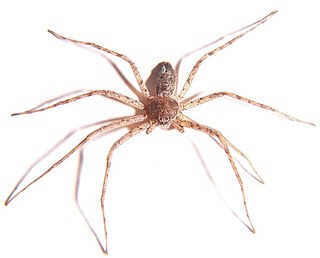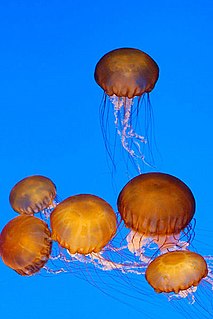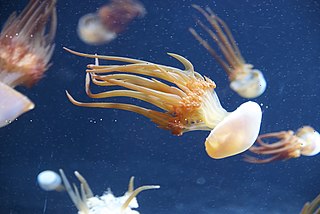
Philodromidae, also known as philodromid crab spiders and running crab spiders, is a family of araneomorph spiders first described by Tord Tamerlan Teodor Thorell in 1870. It contains over 600 species in thirty genera. Most are dull colored- brown, gray, yellowish or mottled with a leaf-like cardiac mark on the anterior dorsal abdomen, and seldom reach above 10 millimetres (0.39 in) long. None of the species build webs, but they do use silk for draglines and egg sacs.

Georg Johann Pfeffer (1854–1931) was a German zoologist, primarily a malacologist, a scientist who studies mollusks.

The Pelagiidae are a family of jellyfish. Members of the family Pelagiidae have no ring canal, and the marginal tentacles arise from umbrella margin.

Ludwig Roselius was a German coffee merchant and founder of the company Kaffee HAG. He was born in Bremen and is credited with the development of commercial decaffeination of coffee. As a patron, he supported artists like Paula Modersohn-Becker and Bernard Hoetger and turned the Böttcherstrasse street in Bremen into an artwork.
Location theory has become an integral part of economic geography, regional science, and spatial economics. Location theory addresses questions of what economic activities are located where and why. Location theory or microeconomic theory generally assumes that agents act in their own self-interest. Firms thus choose locations that maximize their profits and individuals choose locations that maximize their utility.

Chrysaora is a genus of jellyfish, commonly called the sea nettles, in the family Pelagiidae. The origin of the genus name Chrysaora lies in Greek mythology with Chrysaor, brother of Pegasus and son of Poseidon and Medusa. Translated, Chrysaor means "he who has a golden armament."
Laevilitorina is a genus of small sea snails, marine gastropod molluscs in the family Littorinidae, the winkles or periwinkles.
Alexander Wilhelm Götte, best known as Alexander Goette was a German zoologist born in St. Petersburg.
Wilhelm Pelikan was a chemist, anthroposophist, pharmacist, gardener and anthroposophical medicine practitioner.

The Paula Modersohn-Becker Museum in Bremen, Germany, is the first museum in the world devoted to a female artist. Modersohn-Becker (1876–1907) was one of the most important early Expressionists, and the museum features key works from each of her creative periods.
Die Millionen der Yvette is an East German film. It was released in 1956.

Ludwig Ross was a German classical archaeologist. His family came from northern Scotland, and his father, Colin Ross, married Juliane Auguste Remin and managed the Gut Altekoppel in Bornhöved; their many children included Ludwig's younger brother the painter Karl Ross.
Hans Rupprecht Goette is a German classical archaeologist.

Rhopilema esculentum, the flame jellyfish, is a species of jellyfish native to the warm temperate waters of the Pacific Ocean. It is a popular seafood in southeastern Asia. In the 1980s, research was undertaken in China into its aquaculture, and it is now bred in ponds in that country before being released into the sea to grow to a mature size suitable for the fishery.

Maximilian "Max" Mauff is a German actor.

Sanderia malayensis is a species of jellyfish in the family Pelagiidae, native to the tropical Indo-Pacific. It has a complex life cycle and is thought to be venomous and to have caused injuries to humans.

Chrysaora pacifica, commonly named the Japanese sea nettle, is a jellyfish in the family Pelagiidae. This common species is native to the northwest Pacific Ocean, including Japan and Korea, but it was formerly confused with the larger and more northerly distributed C. melanaster. As a consequence, individuals kept in public aquariums have often been mislabelled as C. melanaster. The medusae of C. pacifica typically has a bell with a diameter of 15–21 cm (5.9–8.3 in). Its sting is strong and can be dangerous to humans.
Sanderia pampinosus is a disc jellyfish in the family Pelagiidae from seas off northern Australia.
Eirene is a genus of hydrozoans in the family Eirenidae.
Acanthascus is a genus of sponges in the family Rossellidae. Species include:











